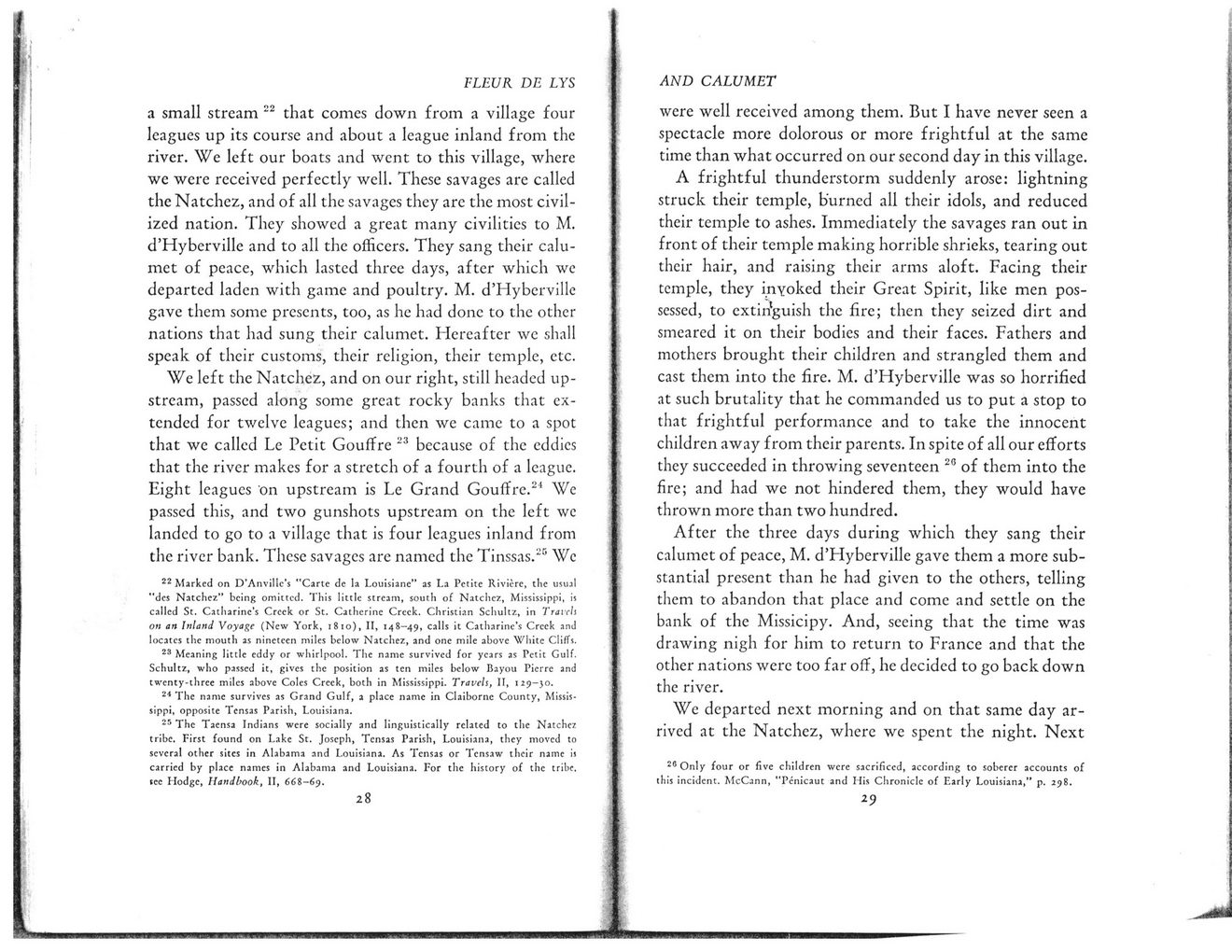This text was obtained via automated optical character recognition.
It has not been edited and may therefore contain several errors.
FLEUR DE LYS a small stream 22 that comes down from a village four leagues up its course and about a league inland from the river. We left our boats and went to this village, where we were received perfectly well. These savages are called the Natchez, and of all the savages they are the most civilized nation. They showed a great many civilities to M. d’Hyberville and to all the officers. They sang their calumet of pcace, which lasted three days, after which we departed laden with game and poultry. M. d’Hyberville gave them some presents, too, as he had done to the other nations that had sung their calumet. Hereafter we shall speak of their customs, their religion, their temple, etc. We left the Natchez, and on our right, still headed upstream, passed along some great rocky banks that extended for twelve leagues; and then we came to a spot that we callcd Le Petit Gouffre 23 because of the eddies that the river makes for a stretch of a fourth of a league. Eight leagues on upstream is Le Grand Gouffre.24 We passed this, and two gunshots upstream on the left wc landed to go to a village that is four leagues inland from the river bank. These savages are named the Tinssas.25 Wc 22 Marked on D’Anvillc’s "Carte de la Louisiane” as La Petite Riviere, the usual "des Natchez” being omitted. This little stream, south of Natchez, Mississippi, is called St. Catharine's Creek or St. Catherine Creek. Christian Schultz, in Travels on an Inland Voyage (New York, 1810), II, 148-49, calls it Catharine’s Creek and loeates the mouth as nineteen miles below Natchez, and one mile above White Cliffs. 23 Meaning little eddy or whirlpool. The name survived for years as Petit Gulf. Schultz, who passed it, gives the position as ten miles below Bayou Pierre and twenty-three miles above Coles Creek, both in Mississippi. Travels, II, 129—30. 24 The name survives as Grand Gulf, a place name in Claiborne County, Mississippi, opposite Tensas Parish, Louisiana. 25 The Taensa Indians were socially and linguistically related to the Natchcz tribe. First found on Lake St. Joseph, Tensas Parish, Louisiana, they moved to several other sites in Alabama and Louisiana. As Tensas or Tcnsaw their name is carricd by place names in Alabama and Louisiana. For the history of the tribe, ice Hodge, Handbook, II, 668-69. AND CALUMET were well received among them. But I have never seen a spectacle more dolorous or more frightful at the same time than what occurred on our second day in this village. A frightful thunderstorm suddenly arose: lightning struck their temple, burned all their idols, and reduced their temple to ashes. Immediately the savages ran out in front of their temple making horrible shrieks, tearing out their hair, and raising their arms aloft. Facing their temple, they invoked their Great Spirit, like men possessed, to extinguish the fire; then they seized dirt and smeared it on their bodies and their faces. Fathers and mothers brought their children and strangled them and cast them into the fire. M. d’Hyberville was so horrified at such brutality that he commanded us to put a stop to that frightful performance and to take the innocent children away from their parents. In spite of all our efforts they succeeded in throwing seventeen 28 of them into the fire; and had we not hindered them, they would have thrown more than two hundred. After the three days during which they sang their calumet of pcace, M. d’Hyberville gave them a more substantial present than he had given to the others, telling them to abandon that place and come and settle on the bank of the Missicipy. And, seeing that the time was drawing nigh for him to return to France and that the other nations were too far off, he decided to go back down the river. We departed next morning and on that same day arrived at the Natchez, where we spent the night. Next 20 Only four or five children were sacrificcd, according to soberer accounts of this incident. McCann, "Penicaut and His Chroniclc of Early Louisiana,” p. 298. 29

Penicaut Narrative Document (020)
